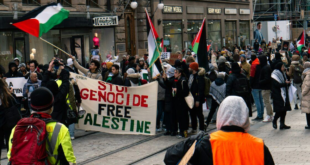KFAR SIR — In the wreckage that was Mariam Salhab’s home, her youngest son picks through a pile of debris, finally pulling free a dust-covered stuffed dinosaur from the broken concrete and scattered children’s toys.
“The children have no clothes, no toys — this is where they play,” she said, gesturing into a gaping hole in the side of the two-storey home where derelict furniture sits in the middle of a ruined room. Small chunks of concrete hang from the ceiling. While many have begun to rebuild after Israel’s offensive against Lebanon and Hizbollah fighters in the south, others like Salhab have found themselves caught in limbo.
They are neither displaced nor able to resume their pre-war routines. They linger in their bombed villages for a few days — just long enough to collect anything that survived the bombing before leaving again.
“We came to get our furniture, our clothes, and we go to live with my brother,” said Mariam’s brother, Salhab Chawki.
He said the three missiles that destroyed their hamlet outside the town of Kfar Sir fell in the final moments of the blistering monthlong war Israel waged on the Shiite group that holds sway over most of southern Lebanon.
“They were the last bombs, I think, not 30 minutes before the end of the war,” he said.
“It’s crazy — where are the rockets?” asked the 41-year-old engineer, referring to the rockets Hizbollah fired at Israel from Lebanese territory. “Here lived only civilians, chickens, goats.” Next door to the home Mariam Salhab once shared with other members of her extended family, an ice cream factory lies in blackened ruins. Cooling coils and other bits of broken machinery are strewn across a grassy lot. On the other side of the home, Salhab’s engineering office is reduced to only its two exterior walls.
A piece of an Israeli missile lies nearby, put on display on a concrete slab amidst flattened tomato plants and stalks of corn. A cow, wounded in the airstrike, bellows furiously from a low cinder-block building.
“Israel — you can see what she did. Our homes, our businesses,” said Mariam, a 35-year-old mother of three.
Another relative sits in a plastic chair in the shade of a tree, cradling a sleeping baby in a makeshift camp built around a folding table and charcoal stove.
Like tens of thousands left homeless by the war, Mariam and her family are waiting for someone to come and offer them assurances that their homes will be rebuilt, their possessions replaced and their lives mended.
The United Nations’ refugee agency said that as many as 300,000 people are still displaced, according to government estimates, but the exact number is unknown.
“We are only doing assessment now. We are going around villages and assessing everything, basically,” UNHCR Spokeswoman Astrid van Genderen Stort told AFP.
She said the survey is looking at how many people have returned and what their needs are. Do they have electricity and water, for example? “I think it will take some time before we know everything,” she said, adding that villages along the border still cannot even be reached by telephone.
In larger southern towns, Hizbollah has assumed the role of saviour, handing out millions of dollars and promises to take care of its own — paying the rent and for furniture for one year as supporters struggle to recover. Hizbollah has been in Kfar Sir, too, Mariam said. In the days after the fighting ended on August 14, fighters came to their hamlet to assess damage, and further assert their authority.
“We have no money — we’re waiting for Hizbollah. For Hassan we have all of this hope,” she said, referring to Hizbollah leader Hassan Nasrallah.
“In one month, [Israel] destroyed all, but we’re still here … we are all Hizbollah,” she said, as a brother-in-law took up one of the family’s few undamaged possessions, a large portrait of Nasrallah, and made a show of cleaning the dust from the frame
 Eurasia Press & News
Eurasia Press & News

